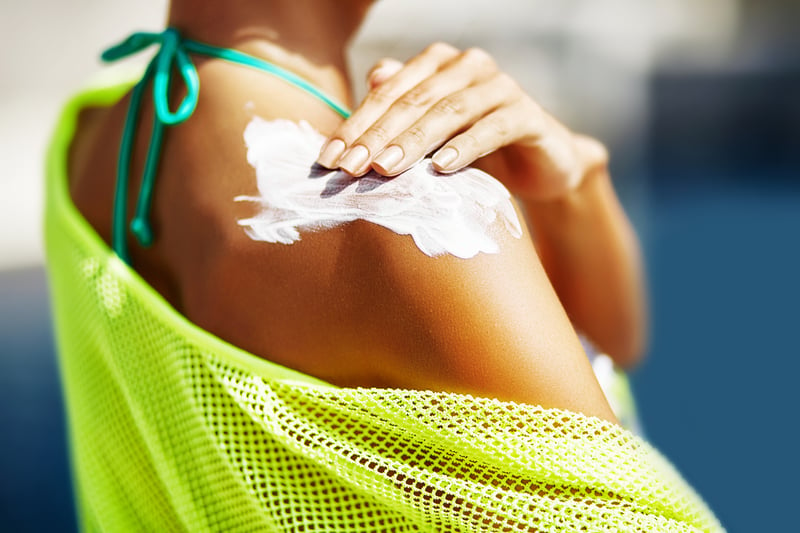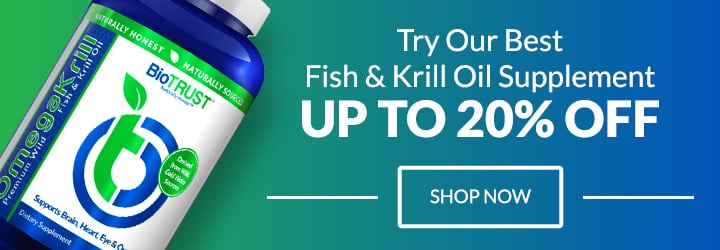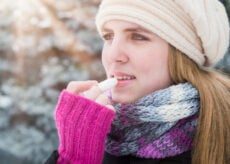Is Sunscreen Actually Bad For You? Find Out Here…

If you’re heading out into the sun even for just a few minutes, you know you should lather up with loads of sunscreen to protect your skin from photoaging, sunburn, and skin cancer. After all, that — along with avoiding intentional sun exposure — has been the mantra for years, so it must be true. Right? Or is it? Now, more and more of us are asking a couple of new questions: Is sun exposure actually good for you? And is sunscreen bad for you?
Let’s examine some of the bigger questions when it comes to sunscreen, such as: 1) How does sunscreen affect levels of the “sunshine vitamin” (i.e., vitamin D), and does a lack of sunshine have negative effects? 2) What types of chemicals are we slathering on our skin, and therefore, allowing to get into our bodies? Do they pose any risks? Could they, in fact, be more harmful than the UV radiation (UVR) from the sun we’ve been taught to avoid?
Let’s dive into these burning answers around “Is Sunscreen Bad For You?”…
Sunscreen: A Short History
Did you know sunscreens (also known as sunblock, sun cream, and suntan lotion) hit the summer scene nearly 100 years ago? Then in the 1930s, the U.S. Public Health Service began warning about health risks related to the sun and provided guidelines to decrease the risk of sunburn. In the following decades, skin cancer became the most common form of cancer, especially in countries with a higher percentage of white residents.
As most of us are aware, the goal of sunscreens was to block ultraviolet (UV) rays, which can burn and damage the skin. The first sunscreens weren’t all that user friendly as they were pasty and didn’t rub in very well. Then in 1944, Coppertone® set about changing all that with the first mass-marketed sunscreen to begin a billion-dollar-per-year industry.
Today, you can find hundreds of different types of lotions, sprays, gels, and other topical solutions designed to either absorb or reflect UVR, and sunscreens are marketed heavily to use every time you face the sun (or, just as a daily precaution even if you don’t plan to be outside) to prevent (or at least slow) development of sunburn, wrinkles, moles, and skin sagging, and more importantly, to help prevent skin melanoma and squamous cell carcinoma, two types of skin cancer. (Sunscreen doesn’t appear to prevent basal cell carcinoma.)
Yet, despite the increased use of sunscreens and decreased sun exposure, skin cancer rates have actually been rising by 4.2% every year, including the most deadly form of melanoma in young adults. In fact, rates of melanoma have tripled over the last 35 years. Ummm….
The Sun, Vitamin D, and Your Health
The vast majority of public health messages over the last 100 years have focused on “the hazards of too much sun exposure.” And, it is true that overexposure to UVR from the sun can prematurely age the skin, damage collagen fibers and vitamin A in the skin, accelerate skin aging, increase the risk of cataracts, and increase the risk of skin cancer. However, according to the World Health Organization (WHO), excessive UV exposure leads to only 0.1% of the “total global burden of disease in disability-adjusted life years” (i.e., DALYs).
On the other end of the spectrum, it’s necessary for our bodies to be exposed to sunlight (more specifically, the sun’s UVB rays) to produce vitamin D, which is vital for a host of functions. According to the same WHO report, a significantly larger annual disease burden of 3.3 billion DALYs is caused by too little UV exposure. This includes major disorders of the musculoskeletal system, increased risk of autoimmune diseases, heart disease, and deadly cancers.
Low levels of vitamin D from lack of sun exposure have been linked to increased risks for colorectal and breast cancers, and raising serum levels (i.e., levels of 25-hydroxyvitamin D) from the average of 15 – 18 to 24 – 55 nanograms per milliliter may help drastically reduce cancer rates. Researchers estimate we may be able to prevent up to 600,000 cases of breast and colorectal cancer per year with adequate sunlight exposure combined with nutrition and supplementation. Previous studies have also found adequate vitamin D markers to also lower the risk of colon, ovary, and kidney cancers. Other cancers that may result from too little time in the sun include Hodgkin lymphoma, pancreatic, prostate, and more.
According to the majority of the studies on vitamin D status and the risk of cancer, “The evidence suggests that efforts to improve vitamin D status, for example by vitamin D supplementation, could reduce cancer incidence and mortality at low cost, with few or no adverse effects.”
“What about skin cancer?” you may be wondering. It turns out that sun exposure can actually protect you from the worst type of skin cancer, melanoma. Since much of the population has been steadily moving indoors since before the 1940s, you may expect melanoma rates to have dropped. Yet the people who work outside, who get 3 to 9 times more solar UV exposure, unexpectedly experience dramatically fewer cases of melanoma. Researchers explain that while intense overexposure and sunburns can initiate melanomas, the increase of UVA exposure (from sunlight streaming through windows, which filter UVB but not UVA rays, for example) combined with low levels of vitamin D seem to promote melanoma growth. Even more surprisingly, one study found that while excessive sun exposure increases the risk for melanoma, “Continued high sun exposure was linked with increased survival rates in patients with early stage melanoma.”
According to the National Institutes of Health, the regulation of at least 1,000 different genes (which is roughly 10% of the total human genome) is related to sufficient vitamin D levels. It’s necessary for everything from regular blood pressure to reducing hospital stays to bone growth to decreased risk of several diseases to reducing tuberculous symptoms. And getting enough sun, especially first thing in the morning, is also necessary for maintaining a normal, healthy circadian rhythm, which supports more restful and rejuvenating sleep. In fact, the less morning light you’re exposed to, the more difficult it is to fall asleep at night and wake up in the morning. By naturally increasing serotonin levels, sunlight can also help you feel more active and alert. Yet, there are also risks if vitamin D levels are too high, so it’s worth it to have your blood tested to see if you have too little, too much, or just the right amount.
Now you know: Unless you’re actually a vampire, sunlight isn’t something you want to avoid at all costs. Rather, it’s finding the right balance for your skin pigmentation (e.g., fair-skinned folks need significantly less sun exposure than those who have a darker skin color) to produce adequate levels of vitamin D naturally.
How Much Sun Exposure is Enough?
While recommendations vary based skin type, time of year, time of day, and latitude (i.e., proximity to the sun), the research indicates that spending about 15 minutes 2 – 3 times a week between 11 am and 3pm during the months of May through October with about 40% of the skin exposed (e.g., face, arms, and legs) for most people (with even less for people who have very fair skin and a bit more for those with darker complexions) is adequate to obtain sufficient levels of vitamin D. (Many researchers also recommend an additional supplementation with around 2,000 IU/day of vitamin D.) Of course, those who have a history of skin cancer or photosensitivity should exercise caution.
Is Sunscreen Bad for You?
Now that you know that sunlight isn’t that bad and you actually need some sun exposure, what if you plan to spend more time out in the sun or if you’re susceptible to burns? For starters, getting more non-burning sun exposure (like suggested above) is protective against sunburn. In other words, it helps your body acclimatize, or adapt, to UVR exposure in a healthy way. On the other hand, reduce acclimatization to UVR and vitamin D production in the skin.
In addition, improving your diet by consuming more omega-3 fats, lots of leafy greens, an abundance of antioxidant-rich foods (especially lutein-containing foods), and foods containing lycopene (such as tomatoes and watermelon) and ß-carotene (like carrots and sweet potatoes) may help you avoid burns. And covering the skin by wearing a hat and covering up with long sleeve shirts is also a good idea. Yet, you might still need additional protection—especially if you are planning to spend hours in the sun, live at higher elevations, or are near water. And let’s face it, wearing long sleeves and long pants with a big floppy hat on the beach may interfere with your water activities. That said, that doesn’t mean you should reach for the closest mass-produced sunscreen.
Why? Is sunscreen bad for you?
Even if you love the coconutty smell of your sunscreen, you probably don’t want to stick it in your mouth and suck it down. In fact, please don’t. Many sunscreens contain potentially toxic ingredients. You may not realize that many of these poisons can make their way into our bodies as they can be absorbed through the skin, our largest organ, which is why reports from both the Environmental Working Group (EWG) and Consumer Reports advise against using many conventional sunscreens, especially on kids.
There are two main classes of sunscreens: Those that use a mineral barrier to protect the skin from the sun and those that use chemical barriers. Many of the chemical barriers are known to be “endocrine disruptors,” which means they can be estrogenic and may also interfere with the thyroid and other hormones in the body. Oxybenzone is one of the most commonly used chemical barriers, and it’s been shown to be an endocrine disruptor that may reduce sperm count in men or lead to endometriosis in women. Thus, the EWG has warned against using any sunscreens with oxybenzone, especially on kids or pregnant/breastfeeding moms.
What’s also surprising is that some of the chemicals used in sunscreen have been shown to potentially lead to skin cancer. For example, the vitamin A derivative retinyl palmitate has been shown to increase the rate of cancer growth by up to 21%.
Other sunscreens contain methlisothiazolione, which was named the “allergen of the year” by the American Contact Dermatitis Society. And other common sunscreen ingredients shown to have toxic effects include octinoxate, homosalate, octisalate, ovtocrylene, para-aminobenzoic acid (PABA), cinnamates, padimate-o, and salicylates.
Another growing segment of sunscreens are the popular sprays. In fact, due to their convenience, there’s been a 30% increase in the number of spray-on sunscreens, which are potentially even more dangerous because they are easily inhaled when applied. Plus, spray-on sunscreens also appear to be less effective at preventing burns than lotions.
Don’t worry. There are safer options so you don’t have to rely only on that floppy hat and long-sleeve shirt option (though I’m sure it looks great on you and is still the simplest and cheapest solution).
So, is sunscreen bad for you? The answer is, that depends…
What Are the Safer Sunscreen Options?
With all the benefits of the sun, it’s still vitally important to avoid overexposure, which can lead to sun damage, sunburn, and skin cancers. Yet, instead of assuming you need sunscreen all day, every day, it should be used only to avoid overexposure to the sun’s rays. The first step to deploy to protect the skin is to shield delicate skin. By wearing clothing, you’ll decrease your burn risk by 27%. And while sunglasses are also vital for protecting your eyes from excessive UV exposure, giving your eyes some unprotected exposure to the sun’s blue light is extremely important for helping support healthy circadian rhythms. Next, take advantage of a shady spot by either finding some or creating your own. This can help reduce the risk of burns by up to 30%.
The EWG has also taken the time and effort to investigate hundreds of sunscreens for their 12th Annual Sunscreen Guide and found these UV filters to have the lowest toxicity concerns:
- Titanium dioxide
- Zinc oxide
- Avobenzone
- Mexoyl SX
The two mineral barriers (titanium dioxide and especially zinc oxide) are considered the safest options.
So, enough already. What are the safest sunscreens to use? According to the 2018 Sunscreen Guide from the EWG (determined after reviewing approximately 650 sunscreens, 250 SPF-labeled moisturizers, and 115 lip products) based on health hazards, UVB protection, UVA protection, the balance of UVA/UVB protection, and stability, the top recommendations include (but aren’t limited to):
- Alba Botanical Mineral Sunscreens
- Badger Mineral Sunscreens
- Burt’s Bees Sunscreen Stick
- Coppertone Defend & Care Face Sunscreen Lotion, SPF 30
- The Honest Co. Sunscreen
- Nature’s Gate Face Vegan Sunscreen, SPF 25
- And Supergoop! Daily Correct CC Cream, SPF 40.
If you’re not seeing your favorite brand/type listed here, you can find all 266 beach and sport sunscreens (mineral and non-mineral options), 91 moisturizers with SPF, and 38 lip balms that meet EWG’s criteria for safer sunscreen options in EWG’s 12th Annual Guide to Sunscreens. This list is the definitive answer to the question “Is Sunscreen Bad For You?”
Finding the Right Balance of Sun, Shade, and Sunscreen
We don’t want to minimize the negative effects of overexposure to sunlight. It can damage the skin to make you look older before your time, and far worse, may lead to dangerous skin cancers. Yet, as we’ve discovered, it’s really about finding the right balance to increase the healthy benefits and minimize the negative effects with the right balance of sunlight (especially in the morning), shade and clothing cover, and then using an appropriate sunscreen.
The WORST case scenario is the person who doesn’t get much sun exposure, but when s/he does, s/he gets burned. “As for what constitutes ‘excessive’ UVR exposure,” researchers have reported, “there is no one-size-fits-all answer: ‘Excessive’ really means inappropriately high for your skin type under a particular level of ambient UVR.”
Enjoy the sun and stay safe out there!
Soothe your Skin Naturally with Ageless Glow
Ageless Glow has been shown to WORK on real people like YOU by reducing the appearance of wrinkles while minimizing visible signs of aging skin, ultimately helping to restore that youthful glow.







